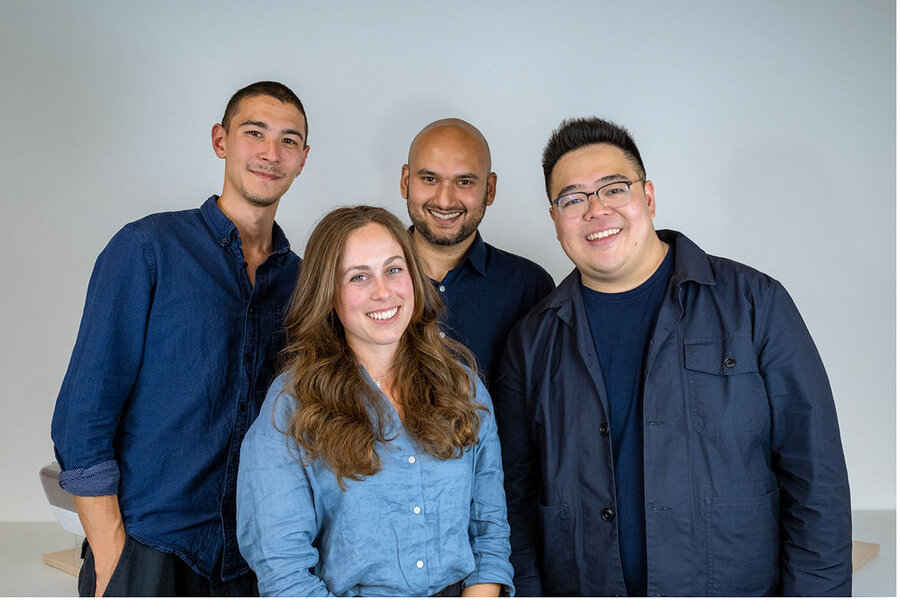A pollution solution where the rubber meets the road
Loading...
Most eco-conscious drivers are focused on their tailpipes, not their tires. But every time a car brakes, accelerates, or changes direction, the friction wears down the exterior of the tire, sending particles into the environment. Some remain suspended in the air, and others get swept into local waterways, where they can have devastating effects on plant and animal life.
Humans produce about 6.7 million tons of tire pollution annually, according to some estimates. That’s more than enough dust and particles to outweigh the Great Pyramid of Giza.
A group of master’s students from Imperial College London and the Royal College of Art had an idea: what if the tires picked up after themselves?
Why We Wrote This
Environmental destruction often comes from unexpected places. But to this team of young inventors, identifying the source of the problem is just the first step toward devising a solution.
The Tyre Collective, a project by recent graduates Hugo Richardson, Siobhan Anderson, Deepak Mallya, and Hanson Cheng, seeks to capture this stealthy pollutant as it flies off the wheel. For the past year, they’ve been working on a device that can attach to the bottom of a car and use electrostatic charges, along with the airflow of the moving wheel, to collect particles for reuse.
The inspiration came from rubbing a balloon over a sweater and seeing the pieces “dancing around,” says Mr. Richardson, chief technical officer of The Tyre Collective. “That led us to the assumption that the particles are charged due to the friction.”
Their prototype collects 60% of all airborne tire emissions on a bicycle wheel and sandpaper road test rig.
The Tyre Collective won the 2020 U.K. James Dyson Award and is now a finalist for the international James Dyson Award, which includes a $35,000 prize. The winners are set to be announced on Nov. 16.
Gavin Whitmore, manager of the Tire Industry Project, an initiative by the World Business Council for Sustainable Development geared toward better understanding the potential health and environmental impact of tires, says his organization is keeping an eye on their work. “We understand very well how difficult it is to try and capture and isolate these particles,” he said. “We’re certainly interested to learn more, because it could be a very, very promising thing.”
Growing research
Tires are more complex than they look. The vulcanized rubber compound that makes up the outermost layer, the tread, often contains sulfur, zinc, carbon black, bisphenol A (BPA), and other chemicals. A lot of that gets swept off the roads by rain, along with motor oil, bits of pavement, and other litter.
A three-year study by the San Francisco Estuary Institute (SFEI) found that stormwater carries roughly 7 trillion microplastic pieces into the bay annually – more than 300 times the discharge from the area’s wastewater treatment plant. Nearly half of those appear to be tire fragments.
“Seeing all these black rubbery particles was a surprise,” said Rebecca Sutton, a senior scientist at SFEI. “Conceptually, there are few reports out there that indicated tires might be a big deal, but no one had really seen that. And honestly, no one had really looked at stormwater.”
“It’s also probably just a tip of the iceberg, because most tire particles are actually smaller than our sieve size,” she added.
Tires are the second-largest source of primary microplastic pollution in the ocean, after synthetic textiles, according to the International Union for Conservation of Nature and Natural Resources. To reduce the amount of tire pollution, Dr. Sutton says governments could consider setting emission standards similar to those for engine exhaust.
But it can be hard to figure out how much material tires are actually shedding, or should be shedding. Tire wear is heavily influenced by the roadway, the weight and type of vehicle, and the driver’s behavior. In London, The Tyre Collective says a busy bus route can generate a grapefruit-size pile of tire dust in a day.
And that dust won’t just sit in water – conservationists worry about the complex recipe of chemicals that leak out from the pieces of tread.
A study conducted in western Washington pointed to tire leachate as the cause of elevated coho salmon deaths in the Puget Sound. Anna O’Brien, a postgraduate student at the University of Toronto, observed tire leachate change the relationship between duckweed, a small plant that flourishes in still water, and the microbes that live on it. The problem is, researchers don’t know exactly which chemicals are responsible for these reactions.
A “huge amount of content” leaches out of tires, says Dr. O’Brien. “And just because something is more abundant doesn’t mean it’s what’s causing the effect,” she says. “Other things about the environment are changing, too. That might mean that these effects we see aren’t constant. We might think we know what the effect of a chemical is only to have it change in the future.”
Mitigating tire damage
While tire companies are investing in research on more sustainable materials, changing the chemical and physical makeup of the tire also poses challenges, says Sarah Amick, vice president of environment, health, safety, and sustainability for the U.S. Tire Manufacturers Association.
“Tires are one of the most regulated products for safety in the United States,” she says. “Ensuring that we can continue to meet those safety requirements, plus adding more renewable and recyclable materials to our tires, it’s a challenge, but our members are working on that.”
For their part, The Tyre Collective did consider developing a biodegradable tire, but quickly ran into several problems, including the realization that most people probably don’t want a “degrading tire” separating their moving cars from the road.
“We decided that a more practical solution would be looking at how we could collect this wear as it is right now,” says Ms. Anderson, the chief scientific officer at The Tyre Collective.
During lockdown, the team has focused on turning their vision into a full-fledged startup. They say several manufacturers have expressed interest in their design, though no partnership has been formalized yet. When restrictions due to COVID-19 ease, they’re looking forward to returning to the lab and producing a set of first-generation prototypes to test with potential partners.
“We’ve been working hard to make it a true business offering,” says Mr. Richardson, “and not just a cool university project.”







